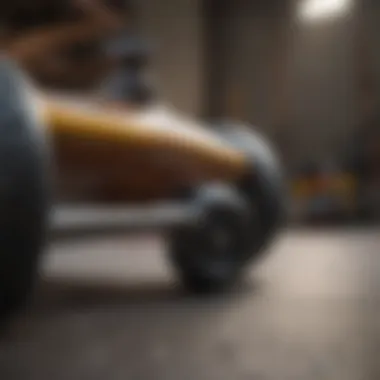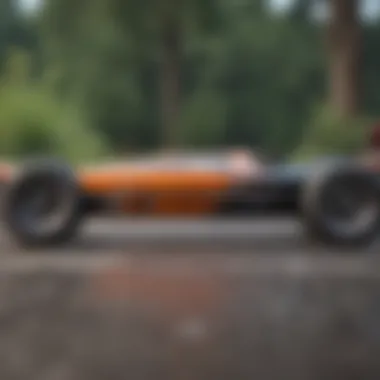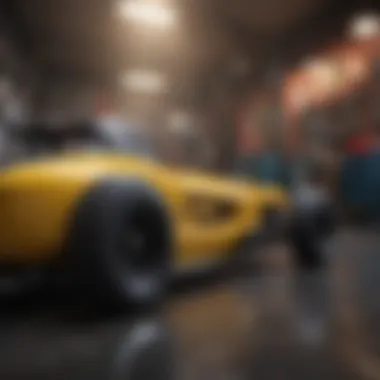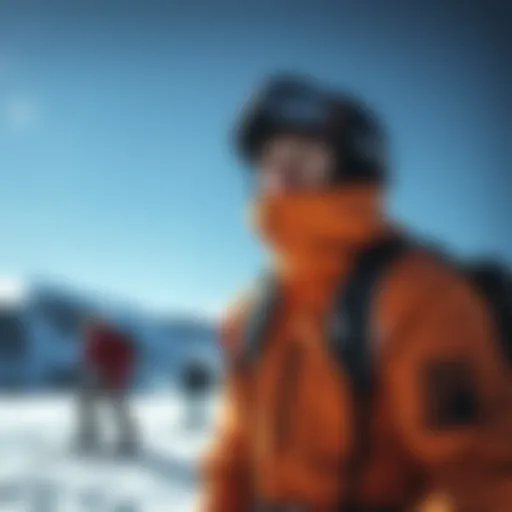Essential Insights into Longboard Trucks Performance


Intro
Longboarding, a thrilling sport that combines speed with skill, all begins with understanding the foundation of your setup: the longboard trucks. These crucial components play an immense role in defining your riding experience, affecting everything from stability at high speeds to your ability to navigate tight corners. Mastering the nuances of longboard trucks is not just for the pros; it’s essential knowledge for anyone interested in making the most of their rides.
In this guide, we will take an in-depth look at longboard trucks, exploring their various types, key features, and the significance of each choice based on riding styles. We'll break things down in a way that's easy to digest, making it accessible for both newcomers and seasoned riders. Moreover, we will compare brands, offer maintenance tips, and discuss the nuances that might be overlooked, ensuring your longboard setup is nothing short of fantastic.
As we embark on this journey together, expect to delve deep—beyond mere definitions into a realm that invites you to consider the implications of your truck choices. Whether you're cruising down the street or tackling steep hills, understanding the right trucks can make all the difference. Let’s roll on and get started!
Understanding Longboard Trucks
Longboard trucks are not just a mere accessory; they are the backbone of any longboard setup. These components significantly influence not only how a board rides but also how a rider experiences speed, stability, and agility. Whether you’re carving down a hill or cruising on a flat path, the design and quality of your trucks can make a world of difference. Without a solid grasp of longboard trucks, one might miss out on optimizing their riding experience.
Definition and Importance
Essentially, longboard trucks are the metal axles attached to the boards, allowing for both the wheels and the rider's weight to be adequately supported. They play a pivotal role in steering, balance, and durability. The truck’s design dictates how a rider interacts with the terrain and maneuvers around obstacles. Without proper knowledge about these components, a rider may end up with a setup that falls flat in performance—both literally and figuratively.
Basic Components of Longboard Trucks
Understanding the basic components of longboard trucks helps riders to select the right one for their style and needs. Each part, from the baseplate to the bushings, has its unique functions and attributes that cater to various riding styles. Here’s a deeper look into these components:
Baseplate
The baseplate is the foundation of the truck. It connects the truck to the board itself, ensuring stability and support. A key characteristic of baseplates is their material—most are made from aluminum, offering a good balance between weight and strength.
For this article, the beneficial feature of a well-designed baseplate is its ability to facilitate energy transfer during turns and maneuvers. However, an overly heavy baseplate can negatively impact the overall feel of the ride, making it crucial to find a balanced option.
Hanger
The hanger is that part of the truck where the wheels are mounted. Its design affects the board's turning radius and stability when at speed. A significant characteristic of hangers is their width; wider hangers generally provide more stability, which is a much-appreciated quality for downhill riders.
The unique feature here is the option for different shapes and profiles. Some riders swear by the more symmetrical shapes for tight turns, while others may prefer asymmetrical designs for versatility. Choosing the right hanger helps in achieving the desired riding experience, but one must be careful since a compromise on width for aesthetic looks might impair performance.
Kingpin
Kingpins are integral in allowing the hanger to pivot. Their design can influence how tightly or loosely the truck turns. A noteworthy characteristic is the angle of the kingpin; it can be adjusted to alter the responsiveness of the longboard.
In our discussion, the benefits of a quality kingpin include enhanced control over turns, which is essential for technical riding styles. Nonetheless, a kingpin that is too loose can lead to instability, especially at high speeds, so this aspect must be finely tuned to the rider's preference.
Bushings
Bushings are the rubber-like components placed at both ends of the kingpin, providing the necessary cushioning and rebound. Their softness or hardness dictates how the board feels underfoot and can influence the stability of a ride. A fundamental characteristic of bushings is their durometer; softer bushings provide easier turns, while harder bushings support stability on faster rides.
The unique feature of bushings lies in their customization potential. Riders can mix and match durometers and shapes to create a tailored feel. This flexibility allows for experimentation to find just the right balance, but not choosing the right bushings can lead to either too much responsiveness or a sluggish ride.
"The choice of your longboard truck components really shapes your riding experience—choose wisely to bring out the best in your rides."
In summary, understanding these basic components is crucial for any longboard rider looking to enhance their performance and cruising experience. Pay close attention to each element, as they all contribute to the overall feel and capabilities of your longboard.
Types of Longboard Trucks
Understanding the various types of longboard trucks is crucial for anyone looking to refine their riding experience. The choice of truck can greatly influence performance, stability, and the overall feel of the ride. Each type possesses unique characteristics that cater to different riding styles and preferences. In this section, we will explore three fundamental categories of longboard trucks: Traditional Trucks, Drop-Through Trucks, and Offset/Reverse Kingpin Trucks. This detailed breakdown will equip you with the knowledge needed to make an informed decision.
Traditional Trucks
Definition and features
Traditional trucks are the most common type found on longboards. These trucks consist of a hanger that is mounted on top of the baseplate. Their design allows for a significant range of motion when turning, which facilitates sharper turns and more aggressive riding. The key characteristic of traditional trucks is their versatility. They generally feature lower ride heights that promote stability at high speeds, making them a popular choice among downhill riders. However, their lower center of gravity can make them less suitable for certain freestyle tricks.
A unique feature of traditional trucks is the presence of a kingpin that’s positioned on the top of the truck, which allows for a tighter steering radius. This feature is beneficial for skaters who prefer more agility in their turns, although it may compromise stability at extreme speeds.
Best uses
Traditional trucks shine in downhill riding and cruising. Their tight turning capabilities make them perfect for navigating sharp turns and hairpin corners, providing confidence to the rider. The best use for these trucks is for riders looking to carve, as they facilitate smooth transitions and fluid movements.


That said, they may not be the best option for those wanting to engage in more technical freestyle riding, where higher stability might be a priority. Riders who primarily cruise or engage in mild downhill skating will find traditional trucks to be advantageous in achieving a satisfying ride.
Drop-Through Trucks
Definition and features
Drop-through trucks take a different approach in design. Unlike traditional trucks, these are mounted through cutouts in the board, allowing the deck to sit lower to the ground. The primary feature of drop-through trucks is their lowered center of gravity, which enhances stability during rides. This design contributes to a more fluid feel, making for easier balance and control during the ride.
A distinct advantage of drop-through trucks is the convenience they offer for riders looking for a setup that accommodates longer board lengths. This enables smoother pushing and faster acceleration while cruising. However, they can sometimes be less responsive during tight turns compared to traditional trucks.
Best uses
The best use for drop-through trucks lies in commuting and leisurely rides. They shine during long-distance pushes; their lower ride height means less energy is required to maintain speed. Riders who seek both comfort and ease of use, particularly in urban settings, will find these trucks to be a perfect match. While they may offer less agility compared to traditional variants, their capacity for control makes them appealing to beginners and seasoned skaters alike.
Offset and Reverse Kingpin Trucks
Definition and features
Offset and reverse kingpin trucks are renowned for their unique design that places the kingpin away from the baseplate, altering the way these trucks respond to steering inputs. This shift creates a more fluid turning experience, catering to riders who prioritize smoothness over tight responsiveness. The key characteristic of reverse kingpin trucks is their suitability for both downhill and freestyle riding styles. These trucks generally provide increased leverage in turns, which leads to a more stable ride at high speeds.
Additionally, offset trucks, with their slightly angled geometry, ensure that the wheels have a more centered position under the board. This design generates a sense of balance and makes the board easier to maneuver without compromising stability. However, they may require slightly more effort to execute sharp turns compared to traditional trucks.
Best uses
The best application for offset and reverse kingpin trucks is in downhill and freestyle riding contexts. They are well-fitted for riders seeking to perform various tricks, thanks to their stability without constraining the ability to carve. Their exceptional maneuverability makes these trucks fit for skating parks and tricks while still remaining formidable at higher speeds. Riders looking to combine intensity with technical finesse will appreciate the traits of these trucks as they engage in complex riding styles.
Choosing the Right Trucks
Selecting the proper longboard trucks is like finding the right shoes for a marathon; it's essential for performance, safety, and overall enjoyment. The correct trucks not only influence your ride but also affect how you tackle various terrains. An optimal choice can elevate your cruising experience or assist in mastering tricks.
Riding Style Considerations
When it comes to picking the right trucks, a big factor is your riding style. Each style has its unique demands that shape the choice of trucks. It's not a one-size-fits-all situation.
Freestyle
Freestyle riding is all about tricks and maneuvers, where creativity rules the day. The important aspect of Freestyle is the truck's responsiveness. For freestyle riders, lightweight trucks with a low profile are a no-brainer. This style allows for easier flipping and maneuvering.
One key characteristic that sets freestyle apart is the agility it provides; riders can spin, slide, or perform tricks effectively. Freestyle trucks tend to have softer bushings, which allow for smooth movements but also require a balanced touch. However, a downside is that these softer bushings may not offer the stability some riders desire during high-speed descents.
Downhill
When riders are seeking speed, downhill longboarding takes the crown. The trucks for downhill riding need to be robust and stable. Key here is stability at high speeds, which typically calls for stiffer trucks that resist movement in turns.
A hallmark of downhill trucks is a wide wheelbase that adds to the overall stability when you're racing downhill. The larger distance between wheels minimizes the risk of speed wobbles, which can be a significant problem during rapid descents. But keep in mind, this stability can come at a cost; these trucks often feel less responsive in tight turns compared to their freestyle counterparts.
Cruising
For those who simply enjoy a smooth ride around the neighborhood or along boardwalks, cruising is the way to go. Here, riders generally seek comfort and control. Cruising trucks, often designed to provide a balance between maneuverability and durability, have a moderate flex that offers both stability and agility.
The unique feature of cruising trucks is their versatility; they perform well at varied speeds and can handle minor roughness in the terrain. A downside, however, is that they might not excel in technical tricks as specialized trucks would. Nonetheless, cruisers love how these trucks can traverse a variety of surfaces.
Truck Width and Height
Just as there are various riding styles, there are varying considerations regarding truck width and height. Truck width impacts your longboard's stability, while the height affects how low you can get during turns. Wider trucks provide better stability, especially for downhill riding, while narrower trucks enhance your ability to perform tricks. A careful balance between width and height can lead to a smoother riding experience.
Material and Durability


The material of your longboard trucks plays a key role in how long they last and how well they perform under different conditions. Most trucks are made from aluminum, offering a good balance of weight and durability. Higher-end options may feature materials like magnesium or advanced composites for reduced weight and enhanced strength. Keep in mind that the more durable the material, the less likely you are to face issues like bending or breaking during intense riding. So, investing in quality is often worth it.
Popular Longboard Truck Brands
When it comes to longboarding, the choice of truck brand can make a world of difference. The importance of selecting the right brand lies not only in performance but also in the trust and reputation built over years. Reputable brands have established themselves through rigorous testing and feedback from riders, ensuring that their products can withstand the rigors of downhilling, carving, or freestyling. Choosing well-known brands often translates to greater durability, better customer support, and access to a wider array of parts and upgrades.
Moreover, individual brands cater to a variety of riding styles and preferences, which is crucial for any rider looking for that perfect setup. Below are some of the most respected names in the industry, each offering unique features and benefits.
Independent Trucks
Independent Trucks have earned a loyal following over many years. Known primarily for their strength and stability, these trucks shine in skateboarding but also transition well to longboarding. Independent’s patented pivot cup design helps enhance turning capabilities while maintaining solid support.
Many riders praise Independent for their reliability, particularly when it comes to downhill riding where control is paramount. Additionally, these trucks often feature customizability in mounting options, allowing riders to tailor their setups effectively. Choosing Independent means investing in a product that's tried and true by generations of skateboarders.
Caliber Trucks
Caliber Trucks are often recognized for their sleek design and high precision. They focus on performance, particularly in downhill and freeride disciplines. The brand’s distinctive reverse kingpin setup promotes an exceptionally smooth ride, perfect for those high-speed turns where stability is key.
Moreover, Caliber Trucks are built to withstand impact, making them suitable for all sorts of terrains. Riders frequently note the ease of adjustments, allowing for quick tweaks based on their individual preferences or riding conditions. This brand is particularly favorable for those seeking reliable performance without sacrificing style.
Paris Trucks
Paris Trucks have made their mark due to their balance of quality and accessibility. With an eye on freestyle and cruising styles, they offer excellent turning radius and responsiveness, which many riders find exhilarating. Moreover, Paris employs high-grade aluminum in their construction, which balances weight effectively without compromising strength.
The traditional kingpin setup allows for a comfortable ride, making these trucks a go-to for beginner to intermediate longboarders. Paris puts a lot of emphasis on aesthetics, so riders looking for a colorful or stylish setup often lean towards this brand. Their wide range of options helps cater to various styles and preferences.
Randal Trucks
Randal Trucks are well-known in the longboarding community for their unique design choices and versatility. They are particularly exceptional for cruising, freighting, and even downhill riding. The double kingpin design facilitates tight turning, which many riders find helpful while navigating through crowded areas or tight corners.
In addition to performance, Randal pays special attention to the longevity of their products. Their trucks are robust, ensuring that they can handle the stress over long-time use. Riders often mention the ease of modifications and parts availability, making Randal a favored brand among those who enjoy fine-tuning their setups.
"Choosing the right truck brand can shape not just your riding experience, but can also elevate your skillset and enjoyment of the sport."
In summation, the choice of longboard truck brand is significant. Each brand offers distinct features and benefits tailored to their niche within the longboarding community. Riders are encouraged to consider their own styles, the terrain they often encounter, and the specific characteristics they value most in a truck when making their decision.
Troubleshooting Truck Issues
When it comes to longboarding, troubleshooting truck issues is not a matter of merely tweaking hardware; it's about enhancing your riding experience. Just like an engine needs regular check-ups, your longboard trucks require attention to maintain performance and safety. In this section, we will delve into common truck-related problems, providing insights into solutions and best practices that can make a world of difference on your next ride.
Common Problems
Noisy Trucks
Noisy trucks can be a real nuisance, turning a peaceful ride into a distracting affair. The sound often stems from several sources such as worn bushings or misaligned components. While the characteristic clatter may seem innocuous, it can be indicative of deeper issues that may compromise your ride. For adventure seekers, knowing the root cause of this noise helps in quick fixes, ensuring smoother experiences.
Unique features of noisy trucks include the tendency to let riders know that something isn't quite right before a more significant failure occurs. The advantage of identifying these sounds early gives riders the chance to inspect the components before heading out on a long journey. On the flip side, ignoring this can risk not just performance but safety too.
Wobbling
Wobbling can rattle even the most seasoned riders. This phenomenon usually occurs due to improper alignment of the trucks or insufficiently tight bushings. Wobbling can be unsettling, particularly at higher speeds, making it crucial to address. The key characteristic here is a lateral instability that can throw off your balance.
It’s beneficial to understand that wobbling is a signal from your board, alerting you to adjust your settings. Unique to wobbling is that it often correlates with how you distribute your weight while riding. If you know your riding style, making quick adjustments can mitigate this readjustment time. However, ignoring it could lead to accidents.
Inefficient Turns


Inefficient turns not just hamper your swift descents but also impact your overall riding experience. If you find yourself drifting wide in corners or struggling to navigate tight spaces, it’s a sure sign that your trucks might need attention. The primary aspect contributing to this issue often lies in the bushings' quality and setup.
A unique feature of inefficient turns is their direct relation to your riding style; whether cruising, going downhill, or doing tricks, the type of turns you aim for will dictate the adjustment of your setup. Addressing this can be favorable as it allows for a tailored approach. However, stiff trucks can also lead to a lack of responsiveness, making it essential to find that sweet spot for performance.
Maintenance Practices
Cleaning
Cleaning your trucks might seem like a mundane chore; however, it's fundamental for longevity. Dirt, grime, and debris can accumulate over time, affecting the performance and even the aesthetics of your board. Regular cleaning helps maintain smooth operation of your trucks, ensuring that metal parts do not suffer from corrosion.
The primary characteristic of a clean truck is its enhanced responsiveness and longevity. For riders who seek a hassle-free ride, this is an undeniable benefit. While some might argue about the time spent during cleaning, the unique feature of this practice is that a little upkeep goes a long way toward preventing much larger issues in the future.
Inspection and Replacement
Oftentimes, it’s easy to overlook the importance of regular inspection and replacement of truck components. This doesn’t merely encompass a visual check; assessing for wear and tear on bushings, kingpins, and other parts can help catch issues before they escalate.
The standout characteristic of a thorough inspection is often a significant reduction in avoidable damages during rides. Emphasizing why this is vital, it sets expectations for longevity and security on the board. Think of inspecting and replacing parts as an investment—avoiding the costlier repairs later by being proactive now.
"A stitch in time saves nine! Addressing any issues promptly can greatly enhance your riding experience."
Upgrading Longboard Trucks
Upgrading your longboard trucks isn't just about switching out components randomly; it’s about enhancing your riding experience. Consider it akin to tuning a beloved musical instrument - each tweak can create a unique sound, or in this case, a distinct ride. As you progress in your longboarding journey, you might find that your needs change, or new technologies become available that elevate performance. Understanding when and how to upgrade your longboard trucks is essential for adventure seekers looking to get the most out of their boards.
When to Upgrade
The signs that it’s time to upgrade your longboard trucks can be quite subtle at first. Pay attention to how your board feels under you. If you start experiencing issues like instability during turns or feeling every bump on the road, these might be clues that a change is due. Additionally, if you have moved onto a different riding style—say from cruising to downhill—you might want to consider upgrades that cater specifically to your new preferences. Some key indicators include:
- Wear and Tear: If the trucks show visible signs of wear, it’s probably a good time to look into new ones.
- Performance Decline: Feeling a decrease in responsiveness? This often warrants an upgrade.
- Changing Your Riding Style: A shift to more extreme shredding requires more tailored equipment.
Choosing Bushings
Bushings play a critical role in your truck performance and overall riding comfort. When considering upgrades, the type of bushings can make or break your setup. They come in various durometers (hardness levels) and shapes, each offering different levels of flex. If you're feeling too loose or too stiff, testing different bushings can be a game changer. Opting for a softer bushing will provide more responsiveness, while firmer ones can help with stability at high speeds.
- Hard Bushings: Better for stability, especially in fast, downhill riding.
- Soft Bushings: Provide easier turns, great for cruising and freestyle.
- Durometer Ratings: Usually range from 78A (soft) to 100A (hard) – pick based on your comfort level.
Modifications and Customizations
Upgrading is not just about replacing parts; it’s about personalizing your ride. Many longboarders dive into modifications to tailor their trucks for specific styles. This could include adjusting the height or even angles of the trucks. You can experiment with riser pads for added height, or even go for inverted kingpins if you feel adventurous. Customization allows riders to:
- Set Specific Angles: Fine-tune your truck angles for your desired turning radius.
- Add Riser Pads: Prevent wheel bite while adding an extra inch or two of height.
- Paint Your Trucks: Go beyond performance and add some style! A splash of paint or stickers can make your longboard uniquely yours.
"Sometimes, it’s the little things - like a new set of bushings - that lead to the biggest rides."
The Future of Longboard Trucks
As the world of longboarding continues to evolve, so do the trucks that support and enhance the experience. The future of longboard trucks is not merely a matter of aesthetics or branding; it reflects a larger conversation about performance, sustainability, and the adaptation of technology to meet the needs of riders who seek both excitement and safety in their adventures on wheels. With innovation driving change, understanding these elements is paramount for enthusiasts eager to stay ahead of the curve.
"In every change, there’s an opportunity, whether it’s in design, materials, or performance enhancements. The future isn’t just about what we can build, but how we can improve the thrill of the ride."
Innovative Materials
The materials used in manufacturing longboard trucks are pivotal in determining their performance and longevity. Traditional metal components have been the norm, but the future is leaning towards advanced composites and lightweight alloys. For instance, carbon fiber is gaining traction due to its exceptional strength-to-weight ratio, which can greatly enhance control and responsiveness. By utilizing these materials, manufacturers can create trucks that are not only lighter, making them easier to handle, but also more resilient to wear and tear, which is critical for aggressive riding styles.
Additionally, the focus on eco-friendly materials is becoming increasingly significant. As environmental concerns rise, riders and manufacturers alike are turning to sustainable practices. Biodegradable polymers and recycled metals are examples of how the industry might shift towards greener alternatives. This could mean a future where not only do trucks perform better, but they also leave a smaller footprint on our planet, aligning with the values of many modern riders.
Design Trends
The aesthetic aspect of longboard trucks is not something to overlook, as design plays a considerable role in rider choice and marketability. Future trends are hinting at a shift towards more customizable designs that allow riders to express their individuality. Color options, shapes, and the ability to mix and match components are expected to flourish. This personal touch not only enhances the emotional connection to the gear but may also influence performance—after all, every rider has their own preference.
Moreover, the integration of technological advancements into truck design is becoming more apparent. Imagine suspension systems that adapt automatically to road conditions, or trucks that feature built-in sensors to provide real-time feedback on performance metrics. Such innovations could revolutionize the way we ride, bridging the gap between traditional longboarding and high-tech engineering.
As the landscape of longboarding trucks continues to shift, the commitment to pushing boundaries remains paramount. Keeping an eye on innovative materials and emerging design trends will not only enhance your setup but also provide a more enriching ride as we move forward into a world where performance meets progress.







